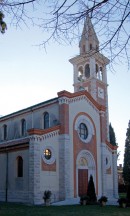Trg Ivana Roba 3a
5290 Šempeter pri Gorici
T: +386 (0)5 335 10 00
F: +386 (0)5 335 10 07
E: info@sempeter-vrtojba.si
Official Hours:
Monday and Friday:
8.00 a.m.-12.00 a.m.
Wednesday:
8.00 a.m.-12.00 a.m. and
2.00 p.m.-4.30 p.m.
VAT no.: SI 44857390
Registration number: 1358227


Cultural sights
We can offer a few culturally interesting sights to the tourists on a limited number of locations, as most of the historically interesting buildings and structures were completely destroyed during World War One.
Vrtojba
The Sacred Heart of Jesus Parish Church
GPS: E13.635323, N45.911568Typical Wells - »p'či«
Decades ago, in the Vrtojba area, the local residents used to pump drinking water from more than fifty wells, known as “p'či” in the local dialect. Today they have a unique value and are of particular interest. Some of them have remained unchanged with time, while others have been renovated. Unfortunately, the water in most of the wells is no longer potable.
 Renato Podbersič: A guide to the watter wells of Vrtojba (.pdf 3.9MB)
Renato Podbersič: A guide to the watter wells of Vrtojba (.pdf 3.9MB)
The World War One Military Cemetery

Hidden among vineyards is a tranquil Austrian cemetery from World War One. The cemetery, with more than one hundred crosses scattered around, is sheltered by the surrounding green vines. On a hot day you can take a welcome short break in the shade of two mighty oak trees that adorn the graveyard.
The Military Watchtower
GPS: E13.617262, N45.908017 The smallest museum in Slovenia can be found in the former military watchtower. The eight metre high tower was built in Vrtojba in 1948, near the former Italian – Yugoslav border, by the Yugoslav People's army. From the end of the Second World War up until 1991 the soldiers used it to keep strict control over the border. It is one of the many silent witnesses to post-war history.
The smallest museum in Slovenia can be found in the former military watchtower. The eight metre high tower was built in Vrtojba in 1948, near the former Italian – Yugoslav border, by the Yugoslav People's army. From the end of the Second World War up until 1991 the soldiers used it to keep strict control over the border. It is one of the many silent witnesses to post-war history.Cultural sights
-
The Sacred heart of Jesus Parish Church
-
Typical Wells - p'či
-
The World War One Military Cemetery
-
The Military Watchtower



